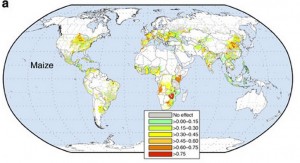The University of Minnesota’s Institute of the Environment published a research article this month in Nature Communications which shows how much of the crop yields of maize, rice, soybeans, and wheat depend on the impacts of the climate. In the study the researchers determined that historically 1/3 of the yield variability of the four crops was due to climate variability. An example of the maps provided in the publication is shown below for maize and identifies the percent of yield variability which can be attributed to climate across the world. Areas shown in white either do not have major plantings in this crop or did not have yield data available. Areas in orange or red have 60 percent or more of their yield variability explained by climate variations.
You can read the story about the research here and see the original maps and research article here. Researchers hope that by understanding where the crops are most vulnerable to climate variations, improved climate forecasting can produce better outcomes for farmers and improve food production resilience in the future.
If you want to see more about the yield variations in different crops due to El Nino here in the Southeast, you can visit www.agroclimate.org and look under “Tools” on the top menu for crop yield information by ENSO phase, crop and county. This summer I expect neutral conditions to continue to occur.
